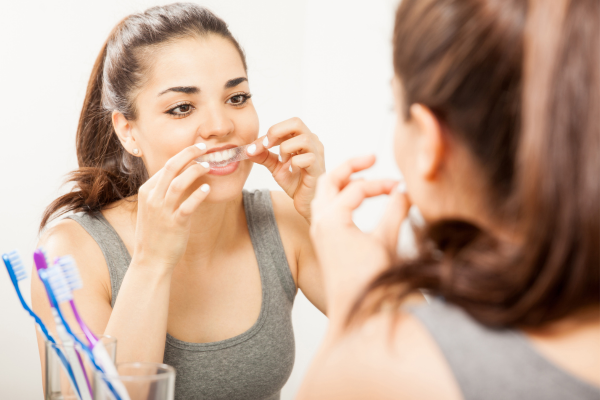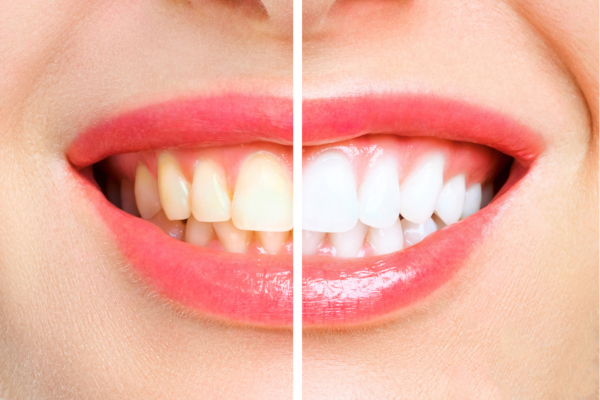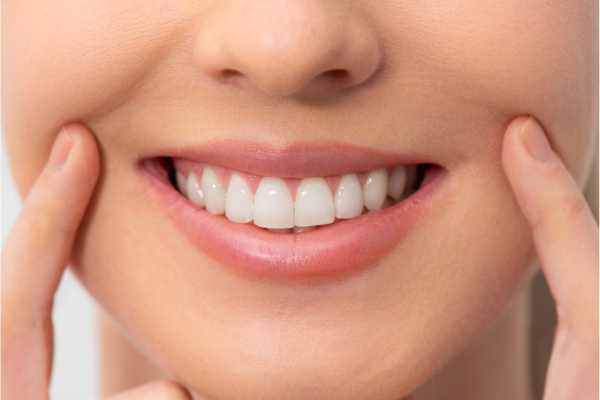Feeling good about your smile is important, whether you’re gearing up for a big celebration, getting ready for a job interview, or preparing for a photoshoot. There are multiple teeth whitening products, of which whitening strips are the most popular. The question is: Are whitening strips bad for your teeth?
While whitening strips may offer a quick solution for your teeth whitening desires, it’s important to be aware that their use can come with unwelcome side effects, such as heightened tooth sensitivity and a potential weakening of your teeth protective enamel layer.
So, let’s delve into the question in focus: Are whitening strips bad for your teeth?
Table of Contents
What Are Whitening Strips?

Whitening strips found in stores are like super thin plastic stickers with special whitening gel on them. This gel contains whitening chemicals such as:
- Hydrogen Peroxide: Makes your enamel white.
- Sodium Hydroxide: Works as a stain buster.
- Polyvinylpyrrolidone (PVP): Acts as a bodyguard for your enamel, stopping new stains.
- Glycerin and hydroxypropyl cellulose: Help the strips stick to your teeth and stay in place.
You have to put these strips on your upper and lower teeth for a certain amount of time. They can make surface stains disappear in just two weeks. But if your tooth stain is inside your tooth, these strips won’t work. That’s why it’s wise to talk to your dentist first to make sure you get the results you’re looking for.
Are Whitening Strips Bad for Your Teeth?
There isn’t just one answer to the question, “Are whitening strips bad for your teeth?” because the answer actually depends on different stuff. In general, if you use whitening strips the right way, they’re safe for most people. But if you don’t follow the instructions and leave them on for too long or use them too much, they are not so great for your teeth.
But why?
The active part, hydrogen peroxide, can whiten your teeth, but if you don’t use it correctly, it can hurt your enamel. Another risk could be exposing your enamel to whitening strips containing chlorine dioxide. It can remove enamel and stains, but taking off enamel is risky and can lead to problems. So, avoid strips with this ingredient because once the enamel is gone, it’s gone for good.
Potential Risks of Teeth Whitening Strips
Most whitening strips have hydrogen peroxide as their main ingredient. But, using it too strongly or for too long can hurt your tooth’s enamel and make your teeth sensitive. Sometimes, it might even make your gums feel weird or uncomfortable.
In really rare situations, these strips could cause an allergy. If that happens, you might notice swelling, itching, or trouble breathing. If you experience any of these signs, stop using the strips immediately and contact a doctor.
Safety Tips for Using Teeth Whitening Strips
To make sure you don’t have any problems when using whitening strips, here are some important things to remember:
Follow the instructions carefully
Read the instructions on the package closely and do exactly what they say. Don’t leave the strips on your teeth for longer than they suggest.
Use the strips in moderation
Using too many whitening strips can hurt your teeth and damage the enamel. Use them as the instructions say, and don’t forget to take breaks between treatments.
Don’t use them if your teeth or gums are damaged
If you have cavities, gum issues, or other dental problems, talk to your dentist before using whitening strips.
Pick a well-known brand
Stick to brands of whitening strips that you know are good and trusted. Check if there are any warnings or recalls before trying a new product.
Think about other options
If your teeth feel sensitive or uncomfortable, you might want to try a whitening method with less strong hydrogen peroxide or go for something like whitening toothpaste or getting your teeth whitened professionally.
Alternatives to Whitening Strips

If you’re looking to brighten your smile but are not sure about whitening strips, there are other options to consider. These alternatives vary in how well they work, how much they cost, and how safe they are. Here are two choices:
Professional Teeth Whitening
One option is to go to the dentist for professional teeth whitening. It involves using stronger whitening stuff than what you find in regular stores. The dentist will put this stuff on your teeth and use a special light or laser to make it work. It usually takes about an hour and can make a big difference in how your teeth look.
Professional teeth whitening is usually safe because dentists know how to minimize side effects like tooth pain or gum irritation. However, it can be expensive, with prices ranging from a few hundred to several thousand dollars depending on where you go and the type of treatment you pick.
Natural Teeth Whitening Remedies
Another option is to try natural ways to whiten your teeth. These are often cheaper and gentler on teeth than the pro treatments or stuff you buy in stores. Here are a few examples:
Baking Soda
Mix a bit of baking soda with water to make a paste, then brush it on your teeth for a minute or two. Rinse well with water. Baking soda is a bit scrubby and can help remove surface stains.
Oil Pulling
Swish a spoonful of coconut oil or another oil in your mouth for 10 to 20 minutes, then spit it out. People believe it helps remove bacteria and junk from your teeth, making them whiter.
Apple Cider Vinegar
Use apple cider vinegar and water to gargle or use as mouthwash. Acetic acid, found in apple cider vinegar, helps to eradicate bacteria and erase stains from your mouth.
Remember, even though natural remedies are usually safe, don’t overdo them and rely on them alone to whiten your teeth. Some, like lemon juice or charcoal, can be too rough and hurt your enamel if you use them too much. Also, these natural ways might not work as well as pro treatments or store-bought stuff.
Teeth Whitening Options in Anoka, MN

While whitening strips can make your smile shine quickly, they might not be the best for your teeth in the long run. If you want a safer way to get fantastic results, contact Anoka Dental.
Our team will treat you with respect and care, just like you deserve. When you come in, you’ll get a warm welcome and top-notch advice from one of our highly trained doctors. You can easily set up a visit online, fill out a contact form, or call us at (763) 421-4002.
FAQs
Should I brush my teeth after using whitening strips?
Usually, it’s not a good idea to brush your teeth right after using whitening strips unless the strip instructions say you can. Whitening strips might make your tooth’s outer layer (enamel) more sensitive, and toothpaste can be rough. When you brush right after using strips, it could harm the surface of your teeth.
How often should you use whitening strips?
Usually, you need to apply whitening strips two times a day for about two weeks on average. The good news is whitening strips work fast. You should notice your teeth looking whiter just a few days after using them, and this brighter smile should stick around for at least four months.
Which is the fastest teeth whitening method?
When it comes to teeth whitening, In-Office Whitening is the cream of the crop. It’s super speedy, taking only about an hour, and the results are awe-inspiring. You’ve likely seen it before – patients sitting under that blue light, and it can make your teeth up to four shades whiter.
